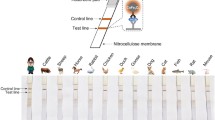Summary
Bloodstained threads (1 cm in length) were tested to identify human origin by a direct ELISA-ABC method using biotinylated antibody against human HbA0. By this method human bloodstains were clearly distinguishable from bloodstains of other species including Japanese monkey. The minimum detection lirait of bloodstains prepared from undiluted human whole blood was 1 : 5, 120 (28 ng Hb) and that of bloodstains from diluted human whole blood was 1 : 640 ≈ 1 : 1, 280. Human Hb was more easily detectable in bloodstains prepared from diluted human blood after extraction with 5% ammonia than after extraction with phosphate-buffered saline.
Zusammenfassung
Es wurde eine direkte ELISA-Methode unter Verwendung des Avidin-Biotin-Komplexes zur Identifizierung von menschlichem Blut an einem verdächtigen Blutfleck (ein Faden mit einer Länge von 1 cm) angewandt. In dieser ELISA-ABC-Methode wurde ein Biotin-gebundener IgG-Antikörper (Ziege) gegen Human-HbA0 verwandt. Mit dieser Methode war ein menschlicher Blutfleck von dem Blutfleck japanischer Affen und anderer Tiere sehr leicht unterscheidbar. Die minimalen Grenzen der postiven Reaktionen erwiesen sich beim Blutfleck mit unverdünntem Blut als 1 : 5, 120 (28 ngHb) verdünnte Extraktionsflüssigkeit und beim Blutfleck mit verdünntem Blut als 1 : 640 ≈ 1 : 1, 280 verdünntes Blut. Der Nachweis von Menschen-Hb im Blutfleck mit verdünntem Blut wurde mit 5% Ammoniak-Extraktionsflüssigkeit leichter erbracht als mit Flüssigkeit des Phosphatpuffersalzes.
Similar content being viewed by others
References
Engvall E, Perlmann P (1971) Enzyme-linked immunosorbent assay (ELISA). Quantitative assay of immnnoglobulin G. Immunochemistry 8:871–874
Tamaki Y, Kishida T (1983) Identification of human bloodstains by Enzyme-linked immunosorbent assay (ELISA). Jpn J Leg Med 37:84–87
Fletcher SM, Dalton P, Harris-Smith PW (1984) Species identification of blood and saliva stains by enzyme-linked immunosorbent assay (ELISA) using monoclonal antibody. J Forensic Sci 29:67–74
Tsutsumi H, Sato M, Nakamura S, Katsumata Y (1986) Differentiation between human and chimpanzee in bloodstains by Enzyme-linked immunosorbent assay (ELISA) using antihuman serum. Z Rechtsmed 97:99–103
Yokoi T, Kimura T, Sagisaka K (1987) Studies on species specificity of human serum proteins by enzyme-linked immunosorbent assay (in Japanese). Res Pract Forensic Med 30:39–46
Tsutsumi H, Htay HH, Sato K, Katsumata Y (1987) Antigenic properties of human and animal bloodstains studied by Enzyme-linked immunosorbent assay (ELISA) using varions antisera against specific plasma proteins. Z Rechtsmed 99:191–196
Yamamoto Y, Tsutsumi A, Ishizu H (1988) Species identification of blood and bloodstains by enzyme-linked immunosorbent assay (ELISA) using anti-human albumin monoclonal antibody. Acta Criminol Japon 54:247–256
Tokiwa K, Niitsu H, Tajima M, Katsura S (1990) Rapid and sensitive identification of human blood by an ELISA-ABC method using a biotinylated antibody against human HbA0. Z Rechtsmed 103:329–334
Madri JA, Barwick KW (1983) Methods in laboratory investigation: use of avidin-biotin complex in au ELISA system. Lab Invest 48:98–107
Oshima N, Hara M (1984) Identification of human hemoglobin by enzyme-linked immunosorbent assay (ELISA) using hemoglobin-coated polystyrene beads (in Japanese). Jpn J Leg Med 38:170–176
Katsura S (1964) A new serological method for the detection of fetal hemoglobin in single erythrocyte. Yokohama Med Bull 15:117–126
Taki K (1976) Hemoglobin Al quantity in individual red cells of normal adults. Tohoku J Exp Med 119:71–77
Kind SS, Cleevely RM (1976) The use of ammoniacal bloodstain extracts in ABO grouping. J Forensic Sci 9:131:134
Chism WJ (1971) A rapid method for grouping dried bloodstains. J Forensic Sci 11:205–206
Kendall C, Ionescu-Matiu, Dreesman GR (1983) Utilization of the biotin/avidin system to amplify the sensitivity of the enzyme-linked immunosorbent assay (ELISA). J Immunol Method 56:329–339
Author information
Authors and Affiliations
Rights and permissions
About this article
Cite this article
Tokiwa, K., Tajima, M., Nishina, M. et al. Application of ELISA-ABC method to the identification of minute human bloodstains. Int J Leg Med 104, 123–126 (1991). https://doi.org/10.1007/BF01369714
Received:
Revised:
Issue Date:
DOI: https://doi.org/10.1007/BF01369714




